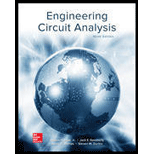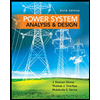
Engineering Circuit Analysis
9th Edition
ISBN: 9780073545516
Author: Hayt, William H. (william Hart), Jr, Kemmerly, Jack E. (jack Ellsworth), Durbin, Steven M.
Publisher: Mcgraw-hill Education,
expand_more
expand_more
format_list_bulleted
Question
Chapter 12, Problem 26E
(a)
To determine
The line current for the given condition.
(b)
To determine
The phase impedance for the given condition.
(c)
To determine
The new power factor and the new power delivered to the load for the given condition.
Expert Solution & Answer
Want to see the full answer?
Check out a sample textbook solution
Students have asked these similar questions
Don't use ai to answer I will report you answer
Derive the transfer functions C'A(s)/T'(s) and T'(s)/C'A0(s). show step by step and write them out so they are easy to read. thank you
4) Find the Norton equivalent of the following circuit.
5 µF
4 cos(200t+30°) A
ele
10 H
www
2 ΚΩ
b
Chapter 12 Solutions
Engineering Circuit Analysis
Ch. 12.1 - Let and . Find (a) Vad; (b) Vbc; (c) Vcd.Ch. 12.2 - Prob. 2PCh. 12.2 - Modify Fig. 12.9 by adding a 1.5 resistance to...Ch. 12.3 - A balanced three-phase three-wire system has a...Ch. 12.3 - A balanced three-phase three-wire system has a...Ch. 12.3 - Three balanced Y-connected loads are installed on...Ch. 12.4 - Each phase of a balanced three-phase -connected...Ch. 12.4 - Prob. 8PCh. 12.5 - Determine the wattmeter reading in Fig. 12.24,...Ch. 12.5 - Prob. 10P
Ch. 12 - Prob. 1ECh. 12 - Prob. 2ECh. 12 - Prob. 3ECh. 12 - Describe what is meant by a polyphase source,...Ch. 12 - Prob. 5ECh. 12 - Prob. 6ECh. 12 - Prob. 7ECh. 12 - Prob. 8ECh. 12 - Prob. 9ECh. 12 - Prob. 10ECh. 12 - The single-phase three-wire system of Fig. 12.31...Ch. 12 - Prob. 12ECh. 12 - Referring to the balanced load represented in Fig....Ch. 12 - Prob. 14ECh. 12 - Prob. 15ECh. 12 - Consider a simple positive phase sequence,...Ch. 12 - Assume the system shown in Fig. 12.34 is balanced,...Ch. 12 - Repeat Exercise 17 with Rw = 10 , and verify your...Ch. 12 - Prob. 19ECh. 12 - Prob. 20ECh. 12 - Prob. 21ECh. 12 - Prob. 22ECh. 12 - A three-phase system is constructed from a...Ch. 12 - Prob. 24ECh. 12 - Each load in the circuit of Fig. 12.34 is composed...Ch. 12 - Prob. 26ECh. 12 - Prob. 27ECh. 12 - A three-phase load is to be powered by a...Ch. 12 - For the two situations described in Exercise 28,...Ch. 12 - Prob. 30ECh. 12 - Prob. 31ECh. 12 - Prob. 32ECh. 12 - Repeat Exercise 32 if Rw = 1 . Verify your...Ch. 12 - Prob. 34ECh. 12 - Prob. 35ECh. 12 - Prob. 36ECh. 12 - A wattmeter is connected into the circuit of Fig....Ch. 12 - Find the reading of the wattmeter connected in the...Ch. 12 - (a) Find both wattmeter readings in Fig. 12.39 if...Ch. 12 - Circuit values for Fig. 12.40 are , , , , . Find...Ch. 12 - Prob. 41ECh. 12 - Prob. 42ECh. 12 - (a) Is the load represented in Fig. 12.41...Ch. 12 - Prob. 44E
Knowledge Booster
Similar questions
- Don't use ai to answer I will report you answerarrow_forwardQ1. Consider the unity feedback control system whose open-loop transfer function is: G(s) = = 40(S + 2) s(s+3)(s + 1)(s + 10) hod of Ziegler-Nichols. By using second method of Ziegler- Nichols, calculate the PID, PI-D and I-PD parameters and make tuning for this for this parameters to get accepting response for the following system, then compare your results for all types controllers? GINarrow_forward1) Use the method of source transformation to find Ix in the following circuit. ΖΩ j4Ω wwwm -j20 60/0° V(+ 602 www 492 -j30 wwwarrow_forward
- Don't use ai to answer I will report you answerarrow_forward3) The sinusoidal voltage source in the following circuit is given by vg = 22.36 cos(5000t + 26.565°) V. Obtain the Thevenin equivalent of the circuit with respect to the terminals a, b. 50 mH Vg 250 Ω 400 nF 50 mH a barrow_forward2) Use the method of source transformation to find Vo in the following circuit. 102 w j30 0.202 10.6 Ω w m ΦΩΣ 10 Ω 40/0° V Vo -j352 -j19arrow_forward
- The distribution function for a random variable X is - F(x) = { 1 − e−²x² x ≥ 0 .Find a) the density function b)the probability x 2 and c) the probability that -3arrow_forward1. Tests of a 10 kVA, 230/2300 V single-phase transformer have yielded the following results: Vacuum test low voltage side: current = 0.45A Po = 70WLow side short circuit test: voltage = 11.6V Pcc = 224.3WDetermine: a. Parameters Rcc and Xcc of the equivalent circuit referring to the secondary.b. Transformer voltage regulation, if feeding a load of 4kVA, fp = 0.75 in delayc. Efficiency if the load is 7kVA, fp = 0.8 inductivearrow_forwardDon't use ai to answer I will report you answerarrow_forwardThe short-circuit test has been carried out on a single-phase transformer of 2500kVA,50kV/10kV, with the following results: 4000V, 50A , 50000 WIt is known that the transformer has a vacuum current equal to 2% and its efficiency at full load fp=1 is 97.5%. Calculate: A. Parameters of the excitation branch. Rfe, JXm, Pob. Relative voltage drops. εcc, εrcc, εxccarrow_forwardMagnetic Field Analysis of a Helical Coil In this lab you will analyse the inductive coil structure shown in Figure 1. It comprises a solid round copper wire of radius a = 0.8mm, wound into a cylindrical spiral having N = 20 turns, major radius R = 10mm and an axial pitch p = 2mm. The coil is excited by a dc current of 1A. R P 1 (a) Analytic Calculations Figure 1: Helical Air-cored Coil Using the expressions developed in the class, estimate the magnetic flux density B at the centre of the coil. Recall from EN1216 that for a long solenoid, the flux density is given by: HONI B l As we saw in the class (see section 4) a modified expression can also be derived that eliminates the need for the 'long' solenoid assumption: R α1 Р â B = HONI 2l (cosa₂-cosα1) 1 Compare the results obtained using equations (1) and (2) and state which solution you would expect to give the best approximation to the real coil behaviour.arrow_forwardI need immediate help with my SIMULINK model. I don't know why but no matter how much a increase or decrease Kc or TI, the graphs are the same. C'A0(s) is the disturbance going through G'D(s). Please check my transfer function blocks by taking the laplace transform of the equations. Any suggestions is welcome greatly! thanksarrow_forwardarrow_back_iosSEE MORE QUESTIONSarrow_forward_ios
Recommended textbooks for you
 Power System Analysis and Design (MindTap Course ...Electrical EngineeringISBN:9781305632134Author:J. Duncan Glover, Thomas Overbye, Mulukutla S. SarmaPublisher:Cengage Learning
Power System Analysis and Design (MindTap Course ...Electrical EngineeringISBN:9781305632134Author:J. Duncan Glover, Thomas Overbye, Mulukutla S. SarmaPublisher:Cengage Learning

Power System Analysis and Design (MindTap Course ...
Electrical Engineering
ISBN:9781305632134
Author:J. Duncan Glover, Thomas Overbye, Mulukutla S. Sarma
Publisher:Cengage Learning